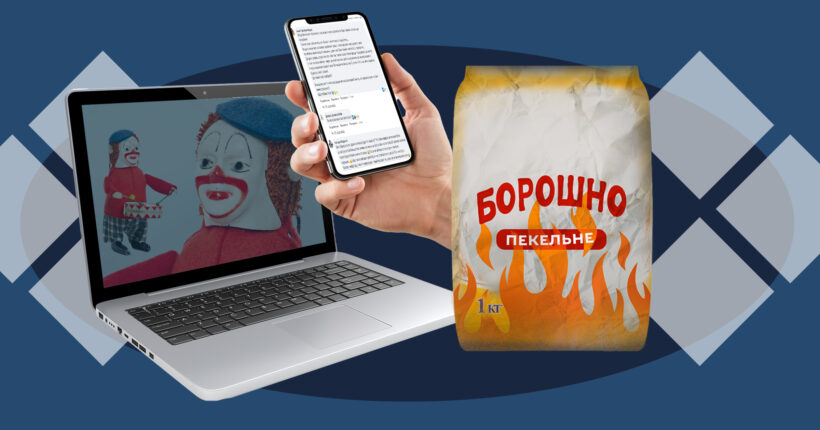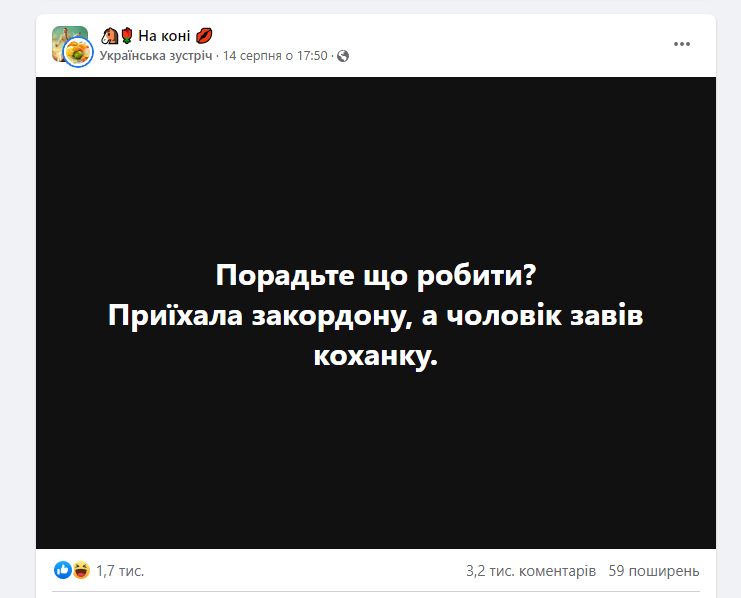
What is the problem?
Russia is always running disinformation campaigns about Ukraine, which involve the use of bot farms. Through this tactic, they are attempting to influence the minds of Ukrainians, causing division and weakening the country. For example, at the end of August 2023, the Center for Combating Disinformation reported that shortly, "according to information from Ukrainian military intelligence, Russian propagandists will promote narratives about mass mobilization and total corruption in Ukraine, as well as about the failure of the counteroffensive of Ukraine's armed forces and the despair of Western partners in Ukraine."
What is the solution?
The Ukrainian intelligence advises citizens to practice good information hygiene and rely solely on official sources of information to avoid becoming tools in the hands of Russian propagandists. However, on social media platforms, which are used for open discussions, this is not always the case. Users freely express their opinions and react to and share posts without always knowing the sources or people involved.
Controlling your emotions is the only practical solution that will help you avoid getting caught by a bot. Rubryka has collaborated with experts in info hygiene to reveal why it works and how it functions precisely.
How do bots work?
A bot is a unique program that carries out specific tasks either automatically or on a predetermined schedule using the same interfaces as a regular user. Essentially, a bot can mimic a typical network user by having its profile, saving favorites, leaving comments, and sharing content on various social media platforms like Facebook, Viber, Telegram, YouTube, and more.
"There is no urine to endure these hellish flours"
Examples of bots' work
The meme referencing "flours" originated in November 2022 due to the efforts of Russian bots. They attempted to initiate a "flash mob" under the hashtag #LightOnZelenskyyOff, encouraging Ukrainians to use excessive electricity as a form of protest against the government, according to the Center for Countering Disinformation. However, an unexpected result came out when Google Translate mistranslated, "I don't have the strength to endure these hellish sufferings without light. Ukrainians want peace, not war" as "There is no urine to endure these hellish flours without light. Ukrainians want the world, not war."

Sometimes bots "forget" what gender they are and thus expose themselves
Aliona Romaniuk, the editor-in-chief of the projects "Nota Ienota" and "On the Other Side of Putin's Lies," provides typical illustrations of bots:
- When a bot account posts in one of the groups saying, "It's my birthday today, and no one wished me well," the photo usually features an older person or perhaps a woman in a military uniform. The bots initiate the greetings, but eventually, real users join in.
Bots gather user data through these types of posts
- When the account operated by the bot also writes: "I came back from overseas, and my husband got a mistress. Can someone advise me on what to do?" This prompts numerous reactions from real users.
- When a bot account requests that you share the most recent photo on your phone, people tend to participate, believing it's just for entertainment. However, the underlying motive is actually data gathering.
That's how bots operate, and they do that quite effectively
One-day bots are less dangerous than hired accounts
There are one-day bots that are easier to recognize, says Aliona Romaniuk, editor-in-chief of the "Nota Ienota" project and "On the Other Side of Putin's Lies."
She lists the signs of a one-day bot:
- unusually strange usernames;
- peculiar photos that are either highly distorted or, conversely, feature professional models or typical images of cats and dogs.

An example of friend requests from alleged Facebook bots
- incomplete user profiles;

Here's an example of an incomplete Facebook profile
- user accounts created recently.
Additionally, Russians are known for creating numerous fake accounts solely to post advertisements. As a result, if you see an ad in your news feed, the expert recommends being cautious about the source. Often, the account promoting the ad may be a fraudulent one.
"On the other hand, there are very high-quality bots," warns Aliona Romaniuk. "This is when real people's accounts are rented, and certain information is distributed on their behalf."
Is it possible to identify high-quality Russian bots?
"There are no official guidelines on detecting Russian bots," Ihor Rozkladai, deputy director and chief expert on media law at the Center for Democracy and the Rule of Law, is convinced. "We can discuss certain behaviors that may lead people to believe so, but I wouldn't be able to say for sure that this is a Russian bot."

On the collage: translation difficulties expose Russian bots / Illustration from the website of the Center for Combating Disinformation
The expert recommends focusing on:
- a user's private profile being closed;
- incorrect translations when it can be determined that the original message was in Russian;
- a user's emotional outbursts, such as using all capital letters or trying to provoke an argument;
- narratives that match the theses the enemy is pushing at the moment.

The Center for Countering Disinformation at the National Security and Defense Council of Ukraine has warned about Russian narratives
"Photos are the weakest point in creating bots"
"Photos aren't the sole means of differentiating between bots when we're discussing something particular," says Oksana Moroz, the founder of the info-hygiene initiative "How not to become a vegetable." – "Photos are the weakest point in creating such accounts."
What exactly should you pay attention to?
According to Oksana Moroz's advice:
The photo should be your primary focus when you open the user's page.
- If there is no photo,
- if they are of the same type, for example, it is the same photo with different filters,
- if these photos are uploaded on one day, or the system of uploading these photos is traced, for example, half of the photos were uploaded on one day and the other half on another day,
it strongly suggests that it's a bot.
"Are you a bot?"
"However, numerous individuals exhibit bot-like behavior, such as having inactive or closed accounts on social media," Oksana Moroz also notes simultaneously.
This question, "Are you a bot?" has now become a way to label someone who does not act or behave in a manner that we desire or perceive as appropriate.
So, according to her, identifying bots falls under the responsibility of social networks rather than individuals. Unfortunately, people have limited means to detect a bot.
"If we had spoken to you two years earlier, I would have given you different information because back then, the technologies were such that you could search and stumble upon a bot. Nowadays, bots are generated automatically, and even an expert cannot confidently determine whether you're interacting with a bot or a real person, as they can appear completely human-like," the expert states.
According to Oksana Moroz, it's nearly impossible to identify bots on Telegram, YouTube, and Viber. These social media platforms are complex even for computer programs to detect. On YouTube, users don't always keep their profiles up-to-date, and the comments are written in a uniquely individual style.
"Therefore, we can de facto only find out that it is a bot by behavior patterns, but this is a separate analysis that a person will definitely not do," Oksana explains.
Does it really work?
So, is it necessary to try to recognize bots?
According to Oksana Moroz, simply detecting bots does not yield any results. As a user, you cannot block or combat them, and engaging in discussion with them only helps spread their information. Merely distinguishing between a bot and a human will not significantly impact, as Russia employs various tactics beyond bots.
 One of the narratives the enemy will be pushing shortly. Illustration of the Center for Combating DisinformationShe provides an example, saying, "One of the functions of bots is to be a tool for launching advertisements. From their accounts, dozens of advertising campaigns about some "betrayals" regarding mobilization, corruption, "Zelensky the drug addict" and so on are advertised every day."
One of the narratives the enemy will be pushing shortly. Illustration of the Center for Combating DisinformationShe provides an example, saying, "One of the functions of bots is to be a tool for launching advertisements. From their accounts, dozens of advertising campaigns about some "betrayals" regarding mobilization, corruption, "Zelensky the drug addict" and so on are advertised every day."
An example of advertising with Russian narratives
It's not so much about a bot launching the advertisement but rather the frequency and repetition of the advertising message.
"People need to see this ad in different interpretations as many times as possible, and then it will work," Oksana Moroz explains.
What should we do then?
"Consider carefully before commenting."
According to Aliona Romanyuk, the chief editor of "Nota Ienota" and " On the Other Side of Putin's Lies," it is essential to consider the intentions of the person who has posted a comment or when replying to someone to interact with information effectively.
"If it incites hatred and discredits Ukrainians, it's crucial to not engage with trolls or fake accounts. When Russia makes some information injection, it activates bots on both sides to promote opposing views and attract real users to polarize Ukrainian society further."
The specialist establishes the fundamental guideline of thinking before leaving a comment since our words, whether correct or incorrect, can cause significant harm.
According to Oksana Moroz, the creator of the "How not to become a vegetable" info-hygiene initiative, the determining factor in whether to engage in or end a discussion should be the indication of harmful behavior rather than whether a person or a bot is involved in the argument:
"Communicating with a person who takes a non-constructive position on social networks does not mean that that person or bot will understand what you are saying on the networks. But your every activity spreads this unconstructiveness to a wider audience thanks to the algorithms of social networks. That is, your friends see what you are talking about, and thus, they also see the bot's messages."
"Some conflicts are inspired"
"It's true that Ukrainians tend to enjoy social media conflicts and often incite them," Aliona Romaniuk says. "However, it is important to recognize that some conflicts are inspired and further fueled by bot farms, with genuine users also becoming involved."
She suggests that sometimes, it's not necessary to focus on whether the person is real but to consider the goal instead: what impact do my thoughts have? Do I have the expertise in this area to provide a comment? For instance, am I qualified as a lawyer or a doctor? In other words, can I make diagnoses? Do I have expertise in any innovative technologies?
When a socially significant topic is being discussed, Russian bots supply the community of "armchair experts."
"There could be someone on the other side of the screen who controls a bot farm or multiple bot accounts. Bots can even infiltrate private groups and chats. In a large-scale operation, they are specifically designed to cause division within society and undermine the credibility of the Ukrainian government, military, volunteers, and healthcare workers. As a result, it is important to be cautious of such information. We can never be sure who is behind the screen. Bots are often indistinguishable from genuine accounts, but they spread harmful misinformation," Aliona Romaniuk sums up.















